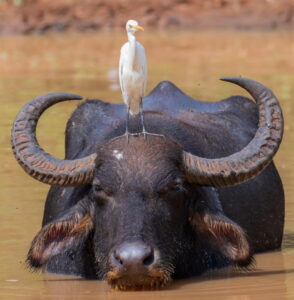Fire, Water, Air and Earth – for more than two millennia, man considered the elements to be the four basic building blocks of all life. Then came the Age of Enlightenment and industrialisation, and science began to break Nature down into ever more and smaller individual parts and to view it as a calculable and usable resource for man. This process of alienation, which led to man no longer seeing himself as a part of Nature, is probably at least to some extent responsible for today’s environmental problems. It is therefore gratifying that a change in thinking is gradually taking place and that science is again beginning to comprehend the different areas of Nature as parts of a whole interrelated system and is also conducting research against this background.
Whoever looks at Nature from this perspective will realise that teamwork, cooperation and symbiosis are omnipresent in Nature.1)vgl. auch https://news.mongabay.com/2022/09/examining-cooperation-in-nature-qa-with-author-kristin-ohlson/ Let us take the well-known example of the (large) water cycle. Water seeps into the ground where it is stored and transferred, it evaporates under the influence of heat (fire) and is transported to its destination by winds and air masses. None of the elements could accomplish this process all by themselves.
 The animal kingdom also provides plenty of examples of cooperation. Cattle egrets, for example, peck harmful insects from water buffaloes and warn them of danger. Ants use swarming tactics to protect their nests and caterpillars that live in the neighbourhood. Ostriches and zebras form packs to defend themselves against predators. Ravens lead wolves to their prey. And cleaner fish are the hygiene police for dozens of other fish in coral reefs. 2)https://magazine.scienceforthepeople.org/vol24-3-cooperation/cooperation-in-animals/
The animal kingdom also provides plenty of examples of cooperation. Cattle egrets, for example, peck harmful insects from water buffaloes and warn them of danger. Ants use swarming tactics to protect their nests and caterpillars that live in the neighbourhood. Ostriches and zebras form packs to defend themselves against predators. Ravens lead wolves to their prey. And cleaner fish are the hygiene police for dozens of other fish in coral reefs. 2)https://magazine.scienceforthepeople.org/vol24-3-cooperation/cooperation-in-animals/Yes, even our body only functions through the constant co-operation of cells and organs. Hence we speak of an organism, a system consisting of different parts that all have their respective function and work together as a unit. Imagine if the liver decided to manage everything on its own! …
Even apparent destruction in Nature often turns out, on closer inspection, to be simply another element in a harmoniously ordered whole. A good example is Yellowstone National Park in the USA. It is “ravaged” by forest fires on average 24 times a year, destroying many hectares of forest. However, the national park is an ecosystem that has adapted to the element of Fire. Many plant species have evolved in a way to survive such fiery conflagrations, and in some cases the plants are strictly dependent on fire in order to thrive at all. And the destruction is often followed by a veritable celebration of life and the park quickly recovers. Because this has now been recognised in Yellowstone, the Park Service is striving to restore and allow the role of fire as a natural process whenever and wherever possible.
Nature functions according to an ordered principle that is always aimed at achieving balance. Regrettably, a disturbed balance is usually caused by rash, thoughtless or even exclusively profit-orientated actions by man, who no longer sees himself as part of the overall structure. By the way, studies have shown that people learn to develop cooperative and ecologically sustainable behaviour when they come into contact with Nature.3)https://www.sciencedirect.com/science/article/pii/S0272494415000195 In other words, we can learn to lead a more social and sustainable life through experiences in and through Nature. Because co-operation is also in our Nature.









